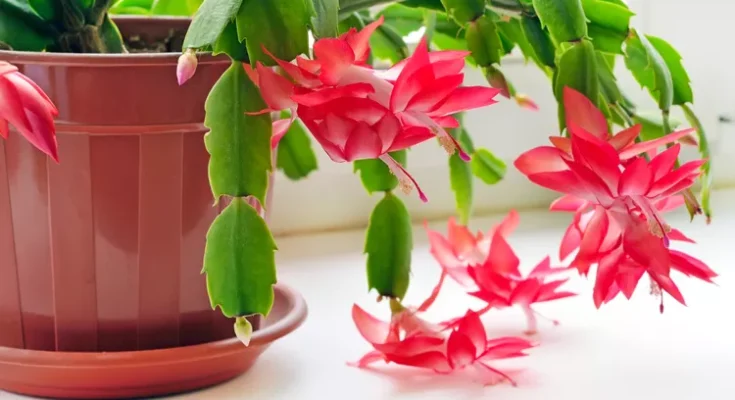“It is common among the industry to control flowering using light control with blackout technology,” says Dr. Dunn. Light control is much less technical in the home environment. You can provide the necessary darkness by covering plants with a black cloth or box at night. Another option is to keep plants in an unused room, basement, closet, or heated garage where lighting can be controlled, perhaps by placing plants under grow lights. Provide dark night conditions for six weeks, at which point flower buds begin to develop.
Once flower buds are visible, plants can be moved back into the home for display. “Keep plants out of direct sunlight, as it can scald leaves,” says Dr. Dunn. The ideal conditions for display include “4-8 hours of indirect light.”
Keep The Heat Low
Christmas cacti bloom best under cool temperatures. Maintain air temperatures between 60 and 68°F during bud development and aim to provide similar conditions in the display location. Christmas cacti are sensitive to being disturbed and may drop buds in response to sudden changes in temperature. “It is best to keep any houseplants, including Christmas cacti, away from drafts (heat/cold),” says Dr. Dunn. Move plants to their display location as soon as buds appear to minimize bud drop.
Feed During Its Growing Season
While it is important to limit fertilizer during bud formation and flowering, feeding plants regularly during the growing season encourages healthier growth and better blooming come fall. Start fertilizing plants once active growth resumes in spring, providing a balanced (10-10-10) fertilizer at half strength. Feed plants monthly throughout the growing season until August.
As autumn approaches, we want the plant to shift its energy to flowering instead of vegetative growth. As such, it is important to restrict nitrogen. Some growers like to provide a nitrogen free, bloom-enhancing fertilizer (for example 0-15-10) in the fall to boost bud formation, although you can simply hold back on fertilizer.
Don’t Overwater
Though Christmas cacti call the rainforest home, they do not require excessively moist soil. In fact, Christmas cacti are sensitive to root rot, so it is important to avoid overwatering plants. During the growing season, water plants when the top inch of soil feels dry to the touch. Reduce water in early fall as you prepare to force plants into bloom. Remember, in their native habitat, Christmas cacti bloom after the rainy season. Creating mild water stress through reduced irrigation can help initiate bud formation.
Plants are more sensitive to water fluctuations as buds and blooms develop. They require even moisture to support the developing flowers, however, plants may drop buds if they receive too much water. One way to optimize soil moisture after buds appear is to provide the same amount of water each week but divide it over two separate waterings.
Timing Matters
Plants require about eight weeks from the beginning of light exclusion until they reach full bloom. To ensure plants bloom when you want them to, identify the desired flowering time and count back eight weeks. For example, begin preparing plants in late September for a Christmas bloom. For optimal bud development, provide dark night conditions for six weeks. Under optimal conditions, flowering can last 5 to 8 weeks.
While we most commonly see Christmas cacti in flower during the holiday season, they can be forced to bloom any time of year. “Even during the long days of the summer, if blackout (complete light exclusion) is implemented from 5pm to 8am, flowering can occur,” says Dr. Dunn. You can even force plants to bloom more than once per year. To encourage repeat blooming, “move [plants] back to short day conditions.”
Pinching And Pruning
Finally, a quick pruning in the summer months can encourage more flowers come winter. Prune plants in early June by pinching back stem tips. Plants respond to pruning with increased branching, which results in more shoot tips that will develop flower buds. Cuttings can be potted into small containers to propagate new plants.
Forcing Christmas cacti to flower requires a bit more planning than with other flowering houseplants, but the brilliant display is well worth the effort. You’ll find the process becomes quite simple once you’ve identified the ideal budding conditions for your home. Remember, “the most important [factor] is day length,” says Dunn. “Specifically short-day (long night) conditions.” Once you get that right, you’ll be rewarded with an abundance of blooms.



